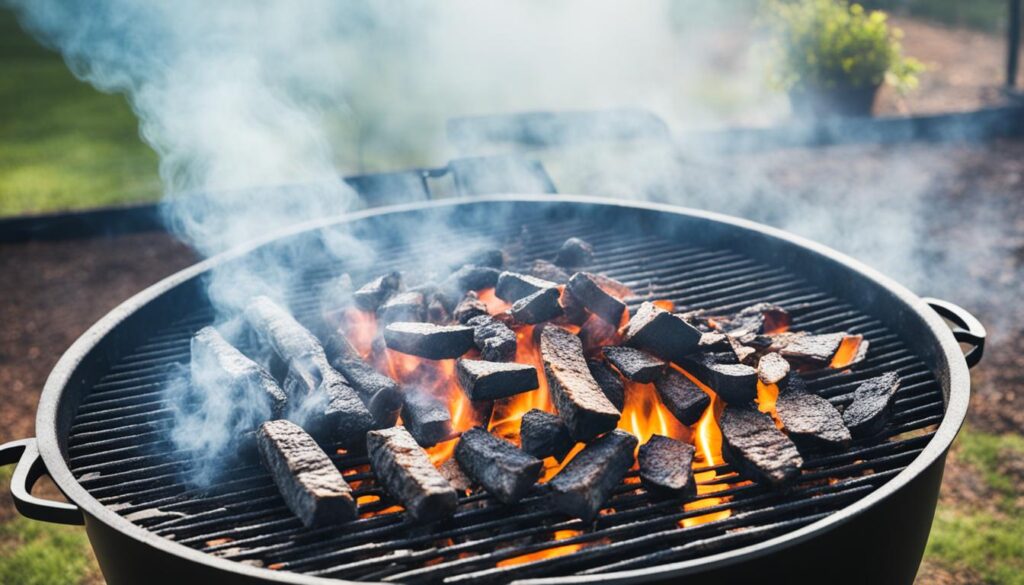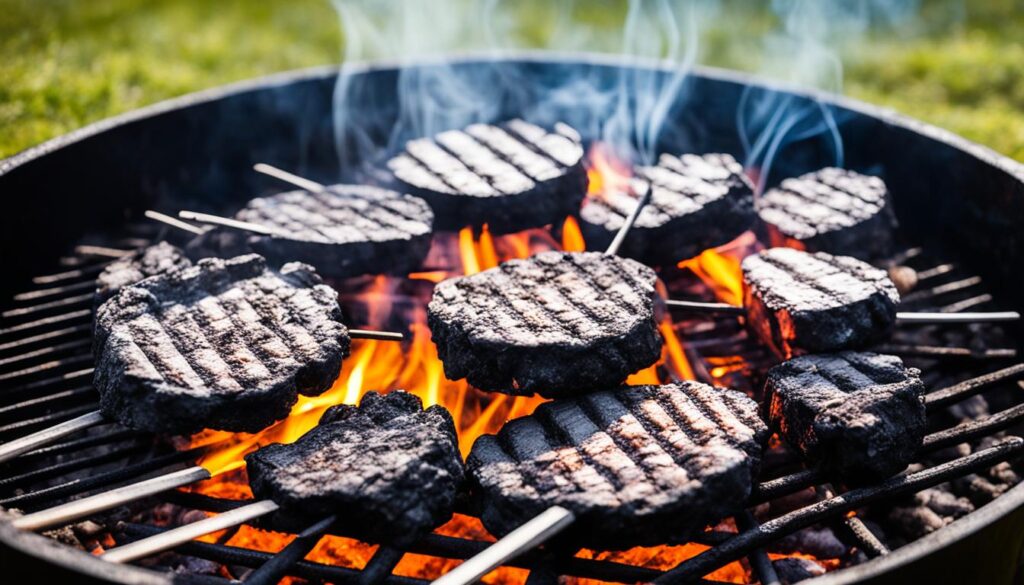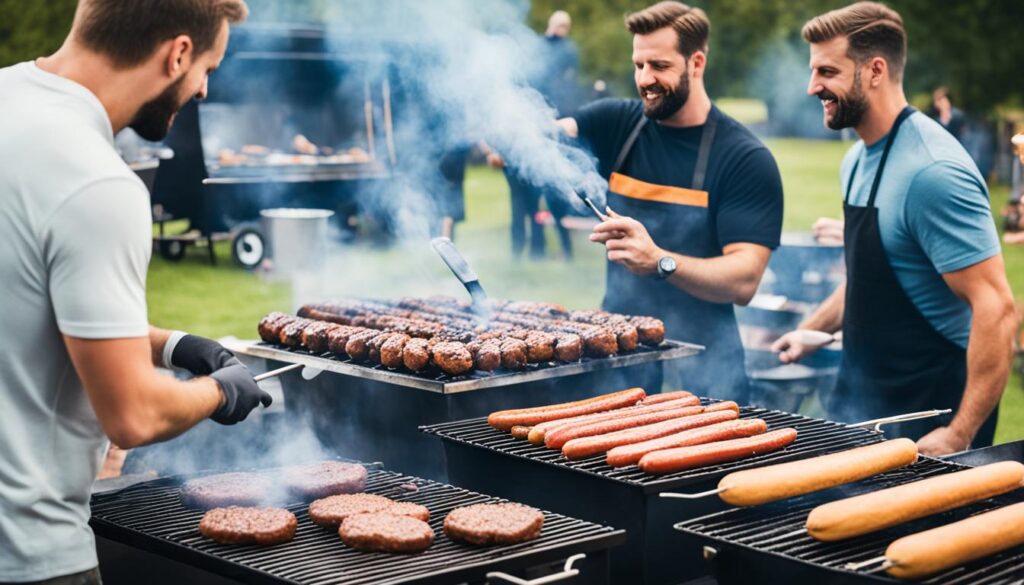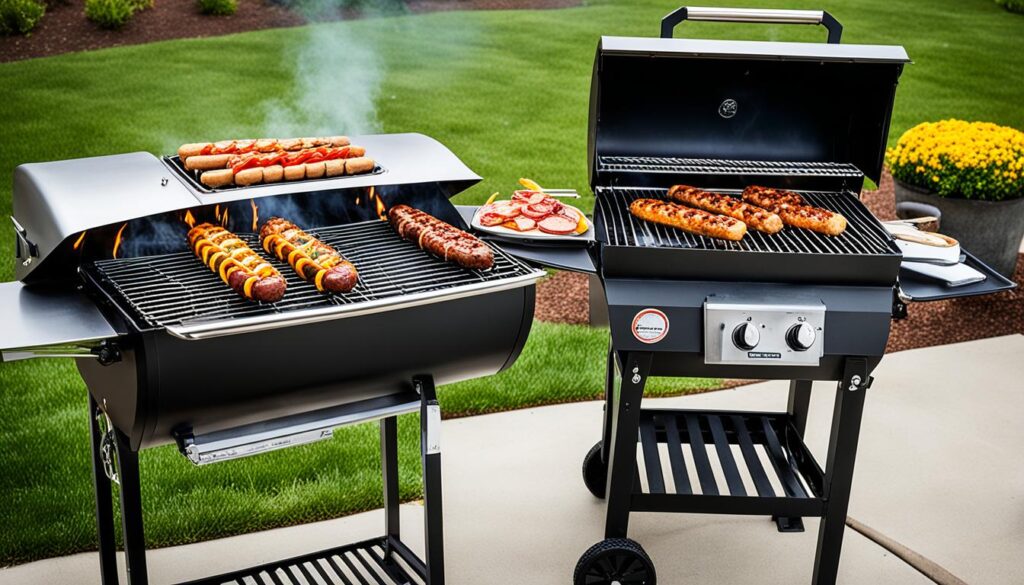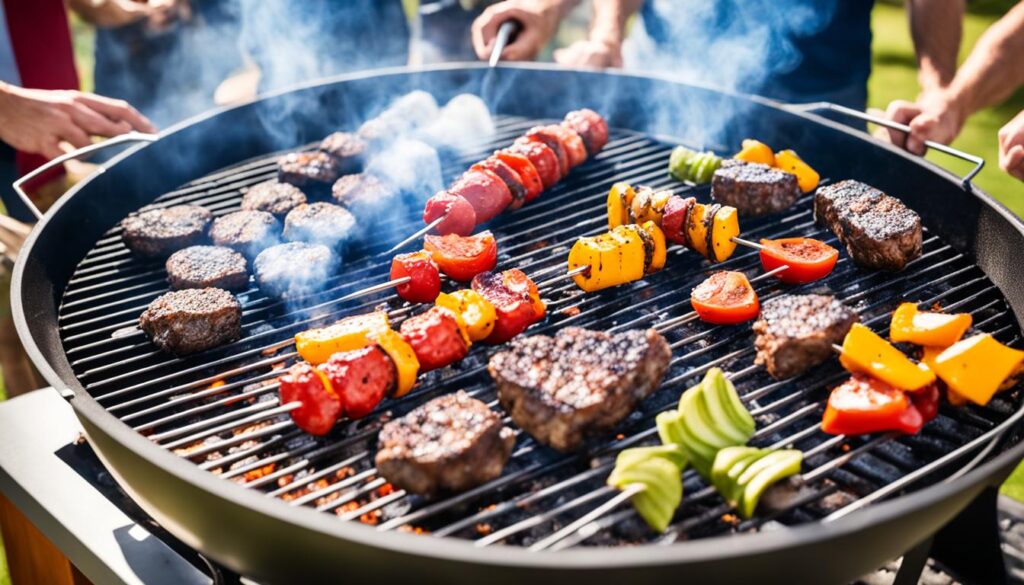Excessive smoke from a charcoal grill can be frustrating and impact the quality of your grilling experience. If you find that your charcoal BBQ is producing too much smoke, don’t worry – there are steps you can take to reduce it. In this article, I will explore the reasons behind excessive smoke and provide you with practical tips on how to minimize it.
Key Takeaways:
- Excessive smoke from a charcoal BBQ can negatively affect the flavor and quality of your food.
- Cleaning your grill regularly can help reduce the buildup of grease and food residue, reducing smoke production.
- Avoid overcrowding the grill to ensure proper airflow and minimize smoke.
- Cooking fatty foods can result in more smoke. Trim excess fat from meat and use a drip pan to catch drippings.
- Maintain the temperature between 212 and 230 degrees Fahrenheit to prevent fat from dripping and burning, causing increased smoke.
Understanding the Role of Smoke in Charcoal BBQ
While some smoke is desirable when smoking meat, understanding the role of smoke in charcoal BBQ is crucial, especially when it comes to regular grilling. Smoke plays a significant role in enhancing the flavor and quality of your food, but excessive smoke can lead to undesirable outcomes. Let’s explore the impact of smoke on charcoal BBQ and how it affects your grilling experience.
Smoke in a charcoal BBQ adds a distinct flavor profile to your grilled dishes, creating a smoky and savory taste that many people enjoy. It infuses the food with unique aromatic compounds, contributing to the overall sensory experience. However, excessive smoke during regular grilling can overpower the natural flavors of the ingredients and result in a bitter or overpowering taste.
When grilling with charcoal, it’s essential to strike the right balance of smoke. Too little smoke may not impart enough flavor, while too much smoke can overpower the natural taste of the food. Achieving the perfect balance of smoke requires a combination of proper heat control, ingredient selection, and cooking techniques.
Flavor Enhancement
The smoke from charcoal BBQ adds depth and complexity to the flavor of your food. The different types of wood or charcoal used in the grilling process can contribute varying flavors to the smoke. For example, hickory imparts a robust and bacon-like essence, while mesquite creates a bold and intense smoky taste.
By selecting the right wood or charcoal and controlling the amount of smoke, you can enhance the taste of your grilled dishes. Certain ingredients, such as beef or pork, pair exceptionally well with smoky flavors, creating a mouthwatering combination that is hard to resist.
Visual Appeal
In addition to flavor, smoke also adds visual appeal to your charcoaled creations. Picture your backyard filled with the tantalizing aroma of grilled food and the sight of rising smoke, creating an ambiance that heightens anticipation. The swirling wisps of smoke can invoke a sense of nostalgia and cue your taste buds for the delicious meal that awaits.
When grilling for a gathering or special occasion, the presence of smoke adds an element of theater to the cooking process. It becomes a sight to behold, igniting conversations and setting the stage for a memorable outdoor culinary experience.
Understanding the role of smoke in charcoal BBQ enables you to harness its potential and elevate your grilling skills. By achieving the perfect balance of smoke, you can enhance the flavor, visual appeal and create an unforgettable grilling experience. In the next section, we will delve into the common causes of excessive smoke in a charcoal BBQ and how to address them effectively.
Common Causes of Excessive Smoke in Charcoal BBQ
Experiencing excessive smoke in your charcoal BBQ can be frustrating, but understanding the common causes can help you troubleshoot and resolve the issue. Here are some of the reasons that may be contributing to the excessive smoke:
- Not enough propane: Check the fuel gauge of your tank to ensure it is not running low. Refilling or replacing the tank will ensure proper gas flow and reduce smoke production.
- Grease or food residue: Excessive smoke can be caused by buildup of grease or food residue on the grill. Regularly clean your grill, including the cooking grates, heat plates, and burner tube ports to prevent grease accumulation and reduce smoke.
- Too much food on the grill: Overcrowding the grill restricts airflow and can lead to excessive smoke. Make sure there is enough space for air to circulate around the food by reducing the amount of food on the grill.
- Fatty foods: Cooking fatty foods can result in excessive smoke due to dripping fat. Trim excess fat from the meat before grilling, avoid over-marinating or oiling the food, and use a drip pan to catch drippings and prevent flare-ups.
- High temperatures: Grilling at excessively high temperatures can cause fat to drip and burn, resulting in increased smoke production. Maintain a temperature between 212 and 230 degrees Fahrenheit for optimal grilling.
- Bad mix of gas and oxygen: A poor mix of gas and oxygen in the charcoal BBQ can contribute to excessive smoke. Check the gas regulator and burner shutters for any issues or blockages. Ensure proper airflow and adjust the shutters if necessary to achieve the correct gas and oxygen mixture.
By identifying the root cause of the excessive smoke, you can take the necessary steps to address the issue and enjoy a cleaner grilling experience. Next, we will discuss some tips for reducing smoke in your charcoal BBQ.
Not Enough Propane
Insufficient propane can lead to excessive smoke in a charcoal BBQ. If there aren’t enough propane levels, it can impact the gas flow and result in a smoky grilling experience. To ensure this doesn’t happen, regularly check the fuel gauge of your tank to make sure it is not running low. If it is, refill or replace the tank to ensure proper gas flow and reduce smoke production.
Having low propane levels can be a common cause of excessive smoke in a charcoal BBQ. It’s important to address this issue to maintain optimal grilling conditions and prevent frustrating outcomes. By monitoring and maintaining the propane levels in your BBQ, you can enjoy a smoother, low-smoke grilling experience.
Grease or Food Residue
Excessive smoke can be caused by grease buildup in a charcoal BBQ and food residue on the grill. It is important to regularly clean your grill to remove any deposits that may accumulate over time. This will help prevent the accumulation of grease and reduce smoke production.
To clean your grill effectively, start by removing the cooking grates and scrubbing them with a grill brush. Pay attention to any areas where grease may have built up. Next, clean the heat plates and burner tube ports to ensure proper airflow. This will help prevent grease from burning and creating smoke.
Avoid using harmful chemicals or abrasive materials when cleaning your grill as they can damage the surface. Instead, use a mild dish soap and warm water solution to remove the grease and food residue. Rinse thoroughly and allow the grill to dry before using it again.
Regular cleaning not only reduces smoke production but also helps extend the lifespan of your grill. By maintaining a clean and well-maintained grill, you can enjoy better grilling results and a more enjoyable outdoor cooking experience.
Cleaning your grill regularly is an essential step in preventing grease buildup and reducing smoke production.
Too Much Food on the Grill
When it comes to grilling on a charcoal BBQ, it’s important to find the right balance. One common mistake that can lead to excessive smoke is overcrowding the grill with too much food. Not only does this restrict airflow, but it also creates a bottleneck for the smoke to escape, resulting in a smoky grill and potentially unevenly cooked food.
To ensure optimal grilling conditions and reduce smoke production, it’s essential to give your food enough space to breathe. By reducing the amount of food on the grill, you allow air to circulate more freely, promoting better heat distribution and minimizing the chances of excessive smoke. If you frequently find yourself cooking large quantities of food, it may be worth considering investing in a larger grill to accommodate your needs.
Creating the perfect grilling environment requires careful attention to detail. By avoiding the overcrowding of your grill and giving your food room to cook, you can minimize smoke production and achieve delicious, evenly cooked meals every time.

Key Takeaways:
- Overcrowding the grill restricts airflow and leads to excessive smoke.
- Give your food enough space by reducing the amount of food on the grill.
- Consider investing in a larger grill if you frequently cook large quantities of food.
With these tips in mind, you’ll be able to enjoy a more pleasurable grilling experience with less smoke and better-cooked food.
Fatty Foods
Cooking fatty foods can result in excessive smoke from the charcoal BBQ due to the dripping fat. When grilling, it’s important to take certain steps to minimize the smoke produced by the fat.
To begin with, trim any excess fat from the meat before placing it on the grill. This will help prevent excessive fat from dripping onto the coals and causing flare-ups, which can produce a substantial amount of smoke. Removing the excess fat not only reduces smoke production but also promotes healthier cooking.
Additionally, it’s advisable to avoid over-marinating or oiling the food, as this can lead to an increase in smoke. While marinating can enhance the flavor of the food, too much oil or marinade can cause excessive smoke when it comes into contact with the hot coals. Be moderate with the amount of marinade or oil you use to avoid an overpowering smoke effect.
Another useful tip is to use a drip pan underneath the grill grate to catch the drippings from the fatty foods. The drip pan serves two purposes: it prevents the fat from dripping onto the burning charcoal, reducing smoke production, and it collects the flavorful drippings, which can be used for basting or making sauces. This not only helps control the smoke but also adds extra flavor to your grilled dishes.
By following these steps, you can effectively minimize the smoke created by fatty foods on your charcoal BBQ. Trim the excess fat, avoid excessive oil or marinade, and use a drip pan to catch the drippings. This will result in a more enjoyable grilling experience with reduced smoke production.
High Temperatures
When it comes to grilling, maintaining the right temperature is crucial for achieving the perfect cook. However, grilling at excessively high temperatures can lead to an undesirable side effect – excessive smoke.
High heat can cause fat to drip and burn, resulting in increased smoke production. To avoid this, it is important to maintain a grilling temperature within the optimal range of 212 to 230 degrees Fahrenheit.
By keeping the temperature in check, you can ensure that the fat on your food is properly rendered without causing excessive smoke. This will help you achieve delicious results without the unwanted smoky flavor.
Remember, a steady and controlled heat source is the key to a successful grilling experience. So, keep an eye on your grilling temperature to minimize smoke production and maximize flavor.

Bad Mix of Gas and Oxygen
A bad mix of gas and oxygen in the charcoal BBQ can contribute to excessive smoke. To ensure optimal performance and reduce smoke production, it is important to check the gas regulator and burner shutters for any issues or blockages. These components play a crucial role in controlling the flow of gas and oxygen within the BBQ.
Inspect the gas regulator to ensure it is functioning correctly and delivering the appropriate amount of gas to the burners. If you notice any leaks, damage, or irregularities, it is important to address them promptly to maintain safe and efficient operation.
The burner shutters, also known as air shutters, control the oxygen-to-gas ratio and are typically located near the burners. Make sure they are not obstructed or clogged with debris, as this can affect the combustion process and lead to excessive smoke.
Proper airflow is key to achieving the correct gas and oxygen mixture. If necessary, adjust the burner shutters to optimize the air-to-gas ratio for clean and efficient combustion. This adjustment may vary depending on the specific BBQ model, so refer to the manufacturer’s instructions for guidance.
By ensuring proper gas and oxygen mixture in your charcoal BBQ, you can minimize smoke production and enjoy a more pleasant grilling experience.
Tips for Checking Gas Regulator and Burner Shutters
| Gas Regulator | Burner Shutters |
|---|---|
|
|
Regular maintenance and inspection of these components will help to ensure that your charcoal BBQ operates efficiently and produces delicious, smoke-free results.
Tips for Reducing Smoke in Charcoal BBQ
To reduce smoke in your charcoal BBQ, follow these tips:
- Adjust your smoker box setup: Ensure that the smoker box is properly positioned and ventilated to allow for the correct amount of smoke production.
- Refill propane if needed: Make sure your propane tank is adequately filled to ensure a consistent gas flow, which can help reduce smoke.
- Clean your grill regularly: Remove any grease, food residue, or ash buildup from your grill to prevent excessive smoke caused by burning debris.
- Reduce the amount of food on the grill: Overcrowding the grill can restrict airflow and lead to more smoke. Cook smaller batches or invest in a larger grill if you frequently cook large quantities of food.
- Trim excess fat from meat: Fat dripping onto the charcoal can create smoke. Trimming excess fat before grilling can help minimize smoke production.
- Control the grilling temperature: Grilling at excessively high temperatures can result in more smoke. Maintain a moderate heat to reduce smoke production.
- Adjust the gas regulator or burner shutters: A bad mix of gas and oxygen can contribute to excessive smoke. Check and adjust the gas regulator and burner shutters to achieve the correct gas and oxygen mixture.
By following these smoke control tips, you can minimize smoke production in your charcoal BBQ and enhance your grilling experience.

The Importance of Achieving Thin Blue Smoke
When it comes to charcoal BBQ, achieving thin blue smoke is essential for a superior grilling experience. The thin blue smoke, also known as “good smoke,” indicates that the coals are burning efficiently and distributing heat evenly. It is the desired smoke that enhances the flavor of the food without leaving a bitter or over-smoked taste.
Unlike thick, billowing smoke, which can result from poor combustion or excessive fuel, thin blue smoke is a sign that your charcoal BBQ is operating optimally. It signifies that the charcoal is smoldering at the ideal temperature and producing the right amount of smoke to impart a delicious smoky flavor to your grilled dishes.
Achieving thin blue smoke requires attention to detail and proper charcoal management. Start by choosing high-quality charcoal briquettes or lump charcoal that burns cleanly and consistently. Avoid using lighter fluid or excessive accelerants, as they can contribute to heavy smoke and unpleasant flavors.
To create thin blue smoke, allow the charcoal to fully ignite and reach the desired temperature before adding your food to the grill. This ensures that the coals are properly lit and producing optimal smoke. Patience is key, as rushing this process may result in uneven heat distribution and excessive smoke.
It’s important to monitor the airflow in your charcoal BBQ to maintain the ideal burning conditions. Adjust the vents or dampers on your grill to regulate the oxygen supply and control the temperature. Proper airflow helps to sustain a clean, efficient burn, resulting in thin blue smoke.
Remember, achieving thin blue smoke is not only about flavor enhancement but also about avoiding an overpowering smoky taste. Too much smoke can make your food taste bitter or acrid, overwhelming the natural flavors of your ingredients. Mastering the art of thin blue smoke will help you achieve perfectly grilled dishes that are infused with a delicate, appetizing smokiness.
So, embrace the thin blue smoke and elevate your charcoal BBQ grilling game. With proper charcoal selection, attention to ignition, and airflow management, you’ll be able to achieve the desirable smoke that enhances the taste and aroma of your grilled creations.
Conclusion
Excessive smoke from a charcoal BBQ can have a negative impact on the flavor and quality of your grilled food. However, by understanding the causes of excessive smoke and implementing the right techniques, you can significantly reduce smoke production and enhance your grilling experience.
First and foremost, it’s important to identify the root cause of the excessive smoke. Whether it’s insufficient propane, grease or food residue buildup, overcrowding the grill, cooking fatty foods, grilling at high temperatures, or a bad mix of gas and oxygen, addressing these issues will help minimize smoke production.
Following the tips outlined in this article can greatly contribute to smoke reduction. Refilling or replacing low propane tanks, regularly cleaning the grill to remove grease and food residue, reducing the amount of food on the grill, trimming excess fat from meat, maintaining optimal grilling temperatures, and ensuring a proper gas and oxygen mixture are all essential steps to achieve a smoke-free grilling experience.
Keep in mind that the goal is to attain thin blue smoke, which indicates the ideal burning and heat distribution of the coals. This thin blue smoke enhances the flavor of your food without overpowering it. By implementing these tips and aiming for thin blue smoke, you can achieve deliciously grilled dishes every time. Happy grilling!
